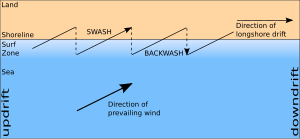Longshore drift: Difference between revisions
Revert of vandalism |
|||
| Line 9: | Line 9: | ||
==Effects== |
==Effects== |
||
[[File:Provincetown Spit Cape Cod.jpg|thumb|left| |
[[File:Provincetown Spit Cape Cod.jpg|thumb|left|Provincetown Spit, at the northern end of [[Cape Cod]], was formed by longshore drift after the end of the last Ice Age. It is still growing today.]] |
||
Where waves are strong, the coast will be [[erosion|eroded]] and sediment carried away and where they are weak sediment will be deposited. This causes material to be moved from areas of strong to areas of weak wave activity. The level of wave activity is determined by many factors such as the direction and [[fetch (geography)|fetch]] of the [[prevailing wind]]. Constant erosion on the coast works with longshore drift to straighten the overall shape of the beach. [[Spit (landform)|Spits]] are landforms that can form by longshore drift when the [[headland]] makes a sharp turn inland. |
Where waves are strong, the coast will be [[erosion|eroded]] and sediment carried away and where they are weak sediment will be deposited. This causes material to be moved from areas of strong to areas of weak wave activity. The level of wave activity is determined by many factors such as the direction and [[fetch (geography)|fetch]] of the [[prevailing wind]]. Constant erosion on the coast works with longshore drift to straighten the overall shape of the beach. [[Spit (landform)|Spits]] are landforms that can form by longshore drift when the [[headland]] makes a sharp turn inland. |
||
Revision as of 06:02, 19 February 2010
This article needs additional citations for verification. (March 2008) |

Longshore drift is the movement of sediments, usually sand, along a coast parallel to the shoreline. It is also called longshore current, littoral drift or LSD (not common, since it also refers to a drug)
Waves approaching the shore break in a region called the surf zone. They carry sediment up the shore in a white, frothy surge called the swash, and down again in the backwash. When the swash approaches the shore at an angle, it will carry and deposit sediment both up and along the beach, but the backwash, acting under gravity, will always carry and deposit its sediment perpendicular to the shoreline, following the line of the steepest gradient. This produces a zig-zag movement of sediment along the beach known as longshore drift. Generally, the largest particles of beach sediment are found updrift, closer to the sediment source. The smallest sediment particles, those which are most easily picked up and suspended by wave action, are transported further downdrift before again being deposited.
Effects

Where waves are strong, the coast will be eroded and sediment carried away and where they are weak sediment will be deposited. This causes material to be moved from areas of strong to areas of weak wave activity. The level of wave activity is determined by many factors such as the direction and fetch of the prevailing wind. Constant erosion on the coast works with longshore drift to straighten the overall shape of the beach. Spits are landforms that can form by longshore drift when the headland makes a sharp turn inland.
Longshore drift can have undesirable effects for humans, such as beach erosion. To prevent this, sea defenses such as groynes or gabions may be employed. Groynes are a common, inexpensive way of protecting a shoreline and act as barriers to physically stop sediment transport in the direction of longshore drift. Their purpose is to preserve a wide beachside (the side in which the prevailing wind occurs). This causes a build-up of the beach on the groyne's updrift side.
Where beaches have become severely eroded by longshore drift and little material is replaced by natural processes, then the material may be artificially replaced by beach nourishment.
References
External links
- Photos, animation and explanation for schools
- Intranet.lissjunior.hants.sch.uk has a brief animation on longshore drift.
- USGS — Coastal Erosion on Cape Cod
- Shore drift
- Longshore drift in South Carolina




